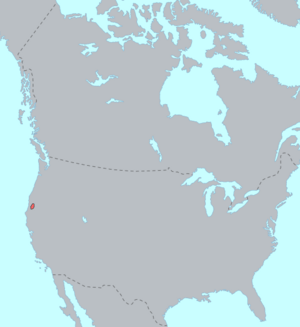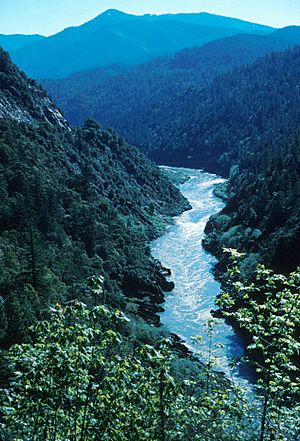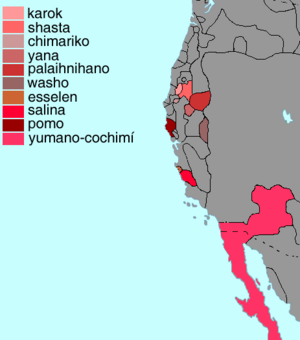Karuk language facts for kids
Quick facts for kids Karuk |
||||
|---|---|---|---|---|
| Araráhih or Ararahih'urípih | ||||
| Region | Northwestern California, United States | |||
| Ethnicity | Karuk | |||
| Native speakers | 12 (2007)e18 | |||
| Language family |
Language isolate or Hokan ?
|
|||
 |
||||
|
||||
The Karuk or Karok language (called Araráhih or Ararahih'uripih by its speakers) is the traditional language of the Karuk people. They live in the area around the Klamath River in Northwestern California. The name ‘Karuk’ comes from the Karuk word káruk, which means “upriver”.
Sadly, Karuk is a severely endangered language. In 2007, there were only about 12 people who spoke it fluently as their first language. Most Karuk people now speak English every day. Since 1949, many people have worked hard to bring the language back. Linguists like Dr. William Bright and Susan Gehr, along with members of the Karuk community, have led these efforts.
Contents
The Karuk Language: A Journey Through Time
The Karuk language began along the Klamath River, between Seiad Valley and Bluff Creek. Before Europeans arrived, it's thought that about 1,500 people spoke Karuk.
In 1949, a linguist named William Bright started studying the Karuk language. At that time, there were a few hundred fluent speakers. But by 2011, fewer than a dozen elders still spoke it fluently. In the 1980s, a standard way to write the language was created.
How Gold Rush Affected the Karuk Language
The Karuk tribe's land was mostly peaceful until beaver trappers came in 1827. Then, in 1848, gold was found in California. Thousands of Europeans rushed to the Klamath River area looking for gold.
Soon, the Karuk land was filled with mining towns and farms. The salmon, which the tribe relied on for food, became scarce because of water pollution from mining. Many Karuk people died from hunger or new diseases brought by the Europeans. Some were even killed or sold into slavery.
Karuk children were sent to boarding schools. There, they were taught to be more "American" and were often forbidden to speak their native language. All these things together caused the Karuk language to slowly disappear. This continued until people started working to bring it back.
How is Karuk Language Related to Others?
Karuk is a language isolate. This means it's very unique and doesn't share many similarities with other languages nearby.
Historically, an American linguist named Edward Sapir suggested that Karuk might be part of the Hokan family. However, there isn't much evidence to strongly support this idea. William Bright wrote that Karuk "is not closely or obviously related to any other (in the area)." But it has been grouped with other Hokan languages in Northern California.
Where is Karuk Language Spoken Today?
Karuk is spoken in the same area where the Karuk people lived before Europeans arrived. This ancestral land is in Northwestern California. It covers parts of Siskiyou, Humboldt, and Del Norte counties.
The language started around the Klamath River. Today, most Karuk speakers live in towns like Somes Bar, Happy Camp, and Orleans. Somes Bar is near the Karuk "Center of the World," called "Katimiin."
The Karuk people originally owned over a million acres of land. But in 1905, this land was taken and made public territory. Later, in the 1970s, Karuk elders bought back some properties. The tribe has now gotten back 1,661 acres of land. They use this land for ceremonies, homes, and managing natural resources.
Sounds of Karuk: Vowels and Consonants
Karuk has 5 main vowel sounds: /i e a o u/. Some of these vowels can be long or short. For example, /a/, /i/, and /u/ can be both long and short. But /e/ and /o/ only appear as long vowels.
The language has 16 consonant sounds. This is a small number compared to most other languages in California. Karuk consonants also don't have special features like glottalization (a sound made by closing the throat) or labialization (a sound made with rounded lips). This is also unusual for a Californian language.
Karuk Tones
Karuk uses a tone system. This means the pitch of your voice changes the meaning of a word. There are three tones: high, low, and falling. Falling tones only happen on long vowels.
| Description | IPA | Spelling |
|---|---|---|
| high-falling tone | /âː/ | âa |
| high tone | /á/ /áː/ | á áa |
| low tone | /à/ /àː/ | a aa |
How Karuk Words are Built
Karuk is a polysynthetic language. This means words can be very long and have many parts. It's known for how it shares information. Skilled Karuk speakers use separate words for new or important details. They use small parts added to words (called affixes) for background details. This helps listeners focus on what's new.
Word Parts: Prefixes and Suffixes
Like many other American Indian Languages, Karuk has a complex system for showing who is doing an action and who the action is done to. These are shown with prefixes (parts added to the beginning of a word) on verbs.
William Bright found that Karuk doesn't have words for cardinal directions (like north, south, east, west). Instead, it uses suffixes (parts added to the end of a word) on verbs to describe direction. Many verbs that show movement have different forms for one person or many people.
Karuk also uses accents on vowels. This means vowels can sound different in each word, which can make the language tricky to learn. Even though its structure might seem similar to other languages, Karuk is very different from its neighbors, like the Yurok language.
Karuk Verbs
Karuk uses prefixes and suffixes in a way that William Bright compared to English words like snort, sniff, and sneeze, which all start with sn-. Here are some examples of prefixes in Karuk:
| Karuk | English Translation |
|---|---|
| im- | involving heat or fire |
| impat | 'to become broken due to heat' |
| imchak | 'to get burnt' |
| imchax | 'to be hot' |
| 'ak- | with the hand |
| 'aknup | 'to thump' |
| 'aktuṽ | 'to pluck at' |
| akxárap | 'to scratch' |
Common Karuk Words and Phrases
Here are some words and phrases from Dr. William Bright's research:
| Karuk | English Translation |
|---|---|
| xâatik vaa ukupítih | Let it do that |
| kári xás pihnêefich upiip, pûuhara. | Then coyote said, "no." |
| pihnêefich | coyote |
| túuyship | mountain |
| koovúra yúruk kámvuunupahitih. | Let it all flow downstream. |
Note: More translations can be found online in the Dictionary section depicting Dr. Bright's research.
Here are some words and phrases from Phil Albers, Jr.'s work:
| Karuk | English Translation |
|---|---|
| hãa | yes |
| pûuhara | no |
| ta'ávahiv | time to eat |
| íikam | it's time to go outside |
| ka'íru | be quiet/quiet down |
Efforts to Revitalize the Karuk Language
The Work of Dr. William Bright and Susan Gehr
Dr. William Bright began studying the Karuk language in 1949 for his doctorate in linguistics at U.C Berkeley. Tribal elders welcomed Bright and gave him the Karuk name Uhyanapatánvaanich, meaning "little word-asker."
About ten years later, Bright published The Karok Language. This book described the Karuk language, its grammar, and how sentences are put together. Bright was special because he included parts of the Karuk culture in his descriptions.
Bright later worked with Susan Gehr, a tribe member and fellow linguist. They created a Karuk dictionary, which was published in 2005. They recorded everyday talks, songs, stories, and poems from fluent Karuk speakers. This helped them capture the language and what it meant to the people who spoke it.
Bright spent over 50 years studying and documenting Karuk. Because of his help to the community, he was the only non-Indian to become an honorary member of the tribe. When he passed away in 2006, he was buried on Karuk land.
Bringing Karuk Back Through Education
American Indian Bilingual Teacher Program
In the late 1980s, Humboldt State University started a program called the "American Indian Bilingual Teacher Credential Program." They brought in teachers from four local tribes: the Hupa, Yurok, Karuk, and Tolowa. These teachers spoke both their native language and English. They would teach American Indian children in local public schools.
The university started this program to help American Indian students. It helped them improve their English for college or develop their native language to keep their culture alive. Bilingual teachers in both Karuk and English taught at Orleans and Happy Camp Elementary Schools. There, children learned how to live in America while keeping their cultural identity.
Karuk Language Restoration Committee
In 1990, the Karuk Language Restoration Committee began working to revive the language. This committee, made up of eight volunteers, created a five-year plan. Their goal was to save the Karuk language and help it become strong in the community again.
Dr. William Bright and tribal member Julian Lang, who was a dedicated researcher of the language, advised the committee. Their studies showed that the language was declining for several reasons:
- Not enough younger fluent speakers.
- A decrease in the total number of speakers.
- The language was not usually taught at home to young children.
- People felt disconnected between using the language and modern life.
- Many tribal members could not read or write in Karuk.
The committee created a five-step plan:
- Recording and writing down fluent speakers talking in Karuk.
- Training more people to become fluent speakers as a long-term goal.
- Making tribal members and local communities aware of how important it is to learn the language, as it carries Karuk culture itself.
- Reviewing the plan and getting feedback from the community.
- Helping the community take part in programs where people can practice and speak Karuk.
Master-Apprentice Language Program
In 1992, a special learning method called the master-apprentice program began. It was started by Advocates for Indigenous California Language Survival to help bring Karuk back.
In this program, people who want to learn Karuk are paired with a fluent native speaker. They spend the whole day with the speaker, and they are only allowed to speak Karuk. This helps the learner become fully immersed in the language. It's an intense program, often lasting 40 hours a week for three years. By 2011, about 20 groups had successfully completed the program.
Dictionaries
- William Bright (2005). Karuk Dictionary. Los Angeles, CA.
See also
 In Spanish: Idioma karok para niños
In Spanish: Idioma karok para niños




